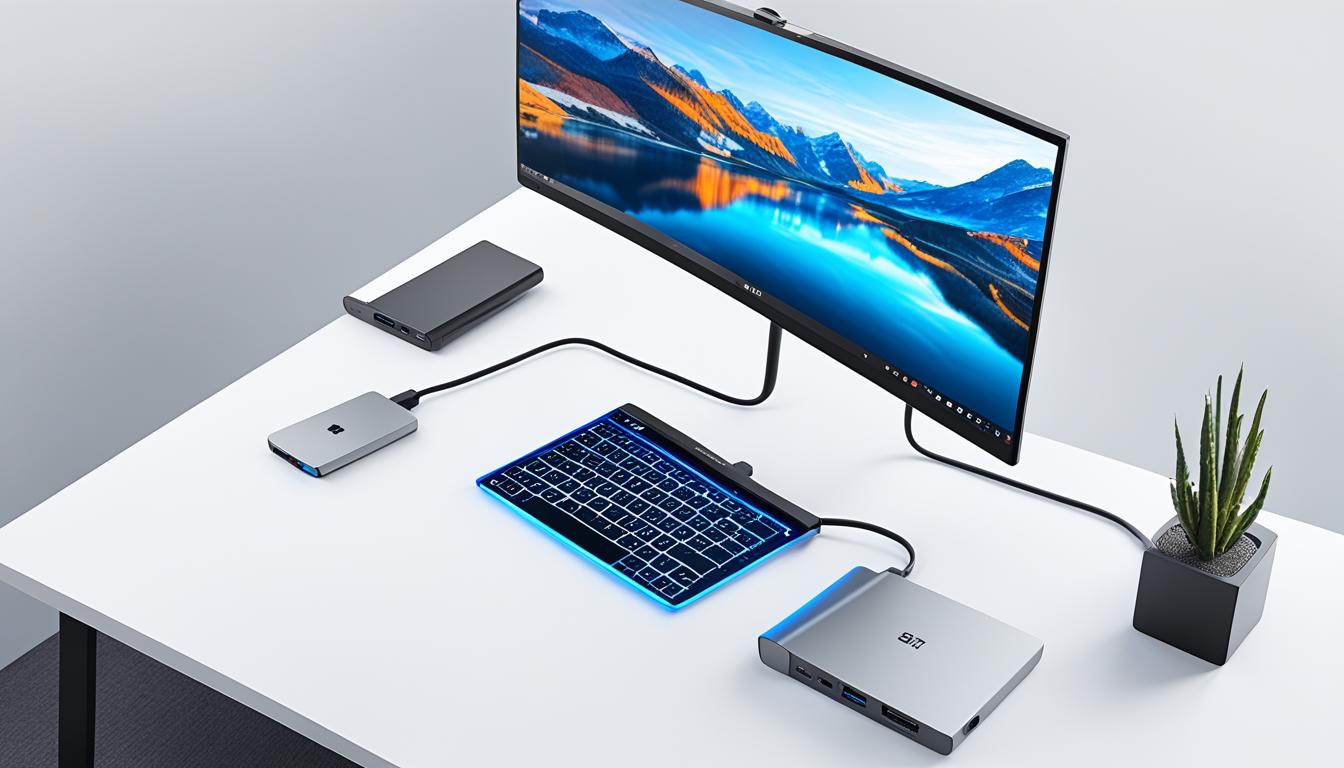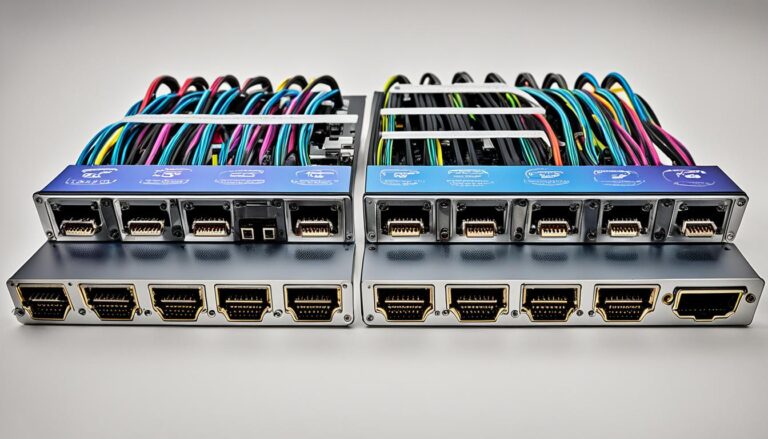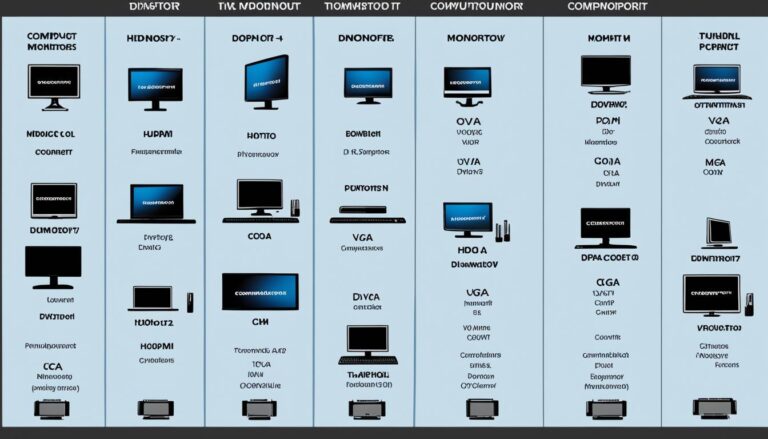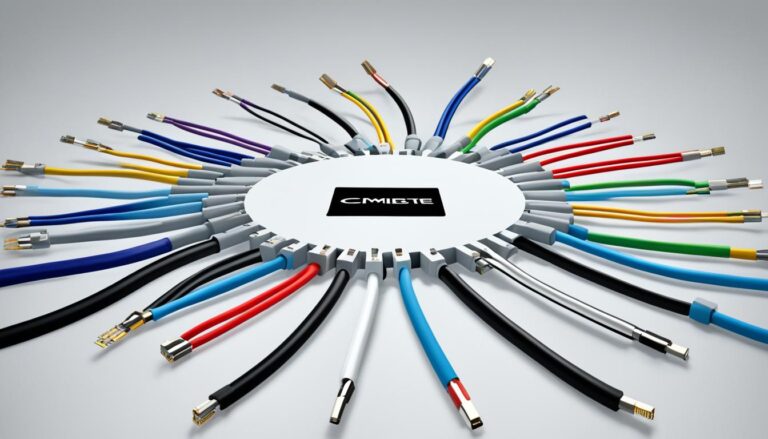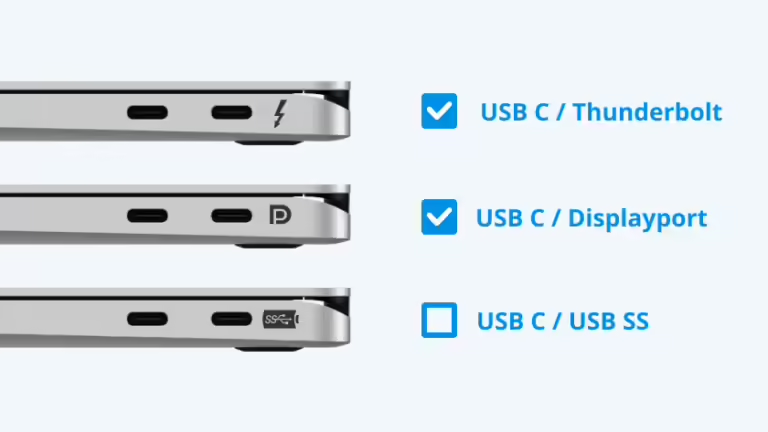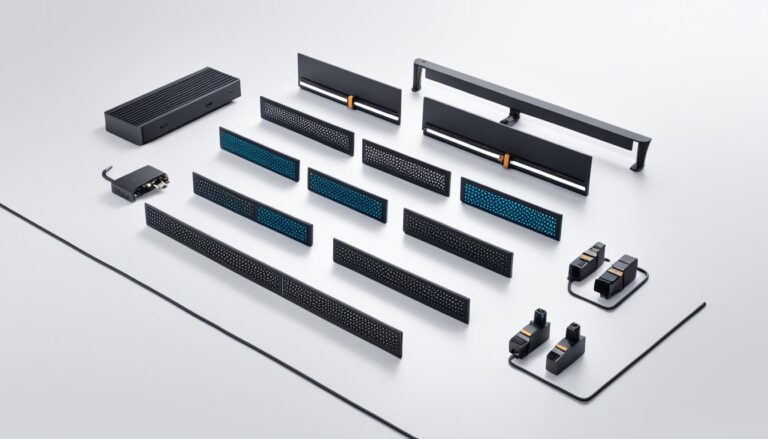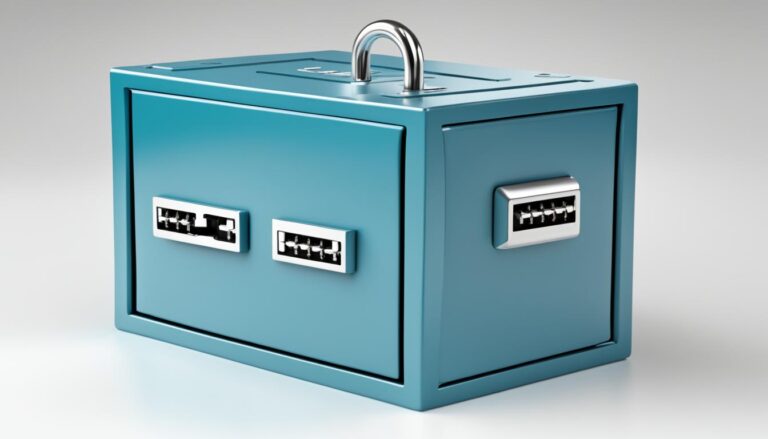Connecting a monitor with USB is handy for making your workspace neater. Use USB-C to make things simpler and costs lower. This type of connection makes things less complicated. It offers quick charging and works with many devices. You also get faster data transfers.
Benefits of USB-C for Monitor Connection
Using USB-C to connect your monitor comes with several advantages. It makes plugging in easier, needing only one port for many tasks. It allows for quick device charging and high-speed data transfer. These points make USB-C a favourite for improving your setup.
USB-C simplifies connections: No more fuss about cable direction. It’s straightforward to use, saving you time and hassle.
Handles multiple duties: USB-C does it all: powering screens, moving data, and connecting gadgets via one port. Say goodbye to desk clutter.
Quick charging without bulky power supplies: Thanks to Power Delivery, charging is swift and direct. It means using one cable for your monitor and laptop charges.
Universal compatibility: USB-C fits with today’s tech: laptops, tablets, and phones. It prepares you for the future, making everything more compatible.
Higher data transfer rates: Compared to older USB types, USB-C is faster. This is great for backing up or transferring big files efficiently.
Here’s a table showing USB-C’s monitor connection perks:
| Benefit | Description |
|---|---|
| Simplified Connections | The reversible connector removes the guesswork and simplifies the connection. |
| Multiple Duties | USB-C covers charging, data transfer, and more through one port. |
| Quick Charging | Its support for Power Delivery means fast charging without big chargers. |
| Universal Compatibility | Being widely compatible, USB-C ensures you’re set for the future. |
| Higher Data Transfer Rates | USB-C’s speed boost is perfect for large files and backups. |
USB-C clearly offers many benefits for monitor connections. It’s a fantastic choice for making your workspace more efficient.
Growing Usage and Adoption of USB-C
USB-C is taking over older USB types such as USB-A, and USB Mini-B. Its versatility and capabilities stand out for monitor connections. It simplifies workstations and removes the need for many external devices. This leads to efficiency and convenience in their usage.
“USB-C is a game-changer for connectivity. It lets us connect many devices with just one USB-C cable. This has made our work areas neater and cut down on cable mess.”
USB-C is now the preferred choice due to its flexibility and efficiency. It’s not just for computer stuff; it’s also in phones, tablets, and more. As more gadgets use USB-C, having USB-C monitors makes everything work smoother together.
USB-C monitors mean less mess with only one cable needed. They let you charge devices fast, including laptops. This simplifies and cleans up your workspace.
Being able to charge laptops with USB-C is a big plus. It means less need for bulky chargers. This is handy for people who move around a lot for work.
As tech moves forward, USB-C monitors will get even more popular. They fit perfectly into modern work areas with their smooth integration and features.
Below you can see how USB-C compares with other USB types:
| USB Type | Transfer Speed | Power Delivery | Reversible Connector |
|---|---|---|---|
| USB-A | Up to 5 Gbps | Power Output | No |
| USB-B | Up to 480 Mbps | Power Input | No |
| USB Mini-B | Up to 480 Mbps | Power Input | No |
| USB-C | Up to 40 Gbps | Power Input/Output | Yes |
USB-C is better than other USB types in speed, power, and ease of use. It has a reversible connector too.
More people are using USB-C and it’s changing how we connect with devices. With its high speed, flexible power, and broad device compatibility, it’s great for monitors. USB-C monitors offer a neater and more productive workspace. They make computing simpler.
Building a Modern Workspace with USB-C Monitors
USB-C monitors are crucial for a modern, efficient workspace. They let IT teams enhance user experience and simplify support. These monitors act as hubs. Users connect their USB-C laptops and gadgets easily. Investing in these monitors adds benefits for both employees and IT teams.
USB-C monitors are versatile. With one cable, users hook up laptops and devices. This cuts down on multiple cables and adapters. It makes the workspace neater. The monitor itself can connect to keyboards, mice, and storage, reducing cable mess.
These monitors support power delivery too. Through USB-C, they can charge devices while showing content. This means no separate power adapters are needed, making things tidier.
Enhanced Productivity and Convenience
USB-C monitors boost productivity and convenience. A single cable connects and charges devices, saving setup time. These monitors also support high-resolution displays. Ideal for video editing, graphic design, and data analysis.
USB-C monitors make workflows simpler and more efficient. They let employees work without the hassle of tangled cables and mismatched connections.
They also let employees have a consistent experience across devices. Whether on a desktop, laptop, or mobile, the experience is seamless. This is great for those who work remotely or switch between devices.
For IT support teams, USB-C monitors reduce support times and connectivity issues. They create a plug-and-play experience. This means less complex setups and troubleshooting. It frees IT teams to tackle more important tasks, boosting efficiency.
Investing in the Future
Choosing USB-C monitors is smart for now and the future. As USB-C grows more common, these monitors ensure compatibility with many devices. This future-proofs your business. It saves costs and brings long-term benefits.
USB-C monitors are key to a modern workspace. They streamline the environment and boost productivity. By choosing USB-C monitors, businesses build an efficient, future-proof workspace. It supports employee satisfaction and productivity.
Understanding USB-C and its Benefits
USB-C, also known as USB Type-C, is a connector type made to speed up transfers. It is found in many devices, like Thunderbolt, HDMI, and DisplayPort. This allows for better connectivity and performance.
“USB-C is a game changer. The ability to connect multiple devices using a single cable has revolutionized the way we work and play.” – John Smith, Senior Tech Analyst
USB-C monitors lead in technology, boosting work and efficiency. These monitors work well with laptops, smartphones, and tablets. This cuts down the need for many cables and adapters.
USB-C monitors are also easy to use. Their connectors can be plugged in any way, making life simpler. They also support video, audio, and data at the same time.
These monitors are great for high-quality videos. They can show 4K and even 8K videos. This makes them perfect for creators and gamers.
The One-Cable Solution
USB-C monitors allow for a tidy desk with their one-cable feature. This single cable powers the monitor and connects devices. It keeps desks neat and visuals consistent.
Traditional setups need many cables, but USB-C monitors make it simple. This helps save space and keeps your work area organised.
More people want USB-C monitors, so there are lots to choose from. You can find the right size, resolution, and features for you.
Buying a USB-C monitor takes your tech to the next level. It’s great for pros wanting efficiency or gamers needing an immersive experience. A USB-C monitor is a smart choice.
| Benefits of USB-C Monitors |
|---|
| Inter-device compatibility |
| Flexibility and ease of use |
| High-resolution video capabilities |
| One-cable solution |
USB-C Monitor Shopping Tips
When looking for a USB-C monitor, think about your budget, what you need, and the type of ports. Prices for these monitors range between £300 to £500 for starters. More expensive models offer better features. It’s also smart to consider USB-C docks for more port options.
First, figure out how much you can spend. This will make your search easier and keep it within your budget. While the basic models start at £300, spending more can get you better quality and features.
Then, think about what you need the monitor for. Is it for work, entertainment, or gaming? Look for things like speed, colour quality, or special video features. Knowing what you want helps you choose the right features.
Port options are also important. Along with USB-C, check if you need HDMI, DisplayPort, or USB-A ports. USB-C docks are great for adding more connectivity. They let you connect other devices to your monitor.
USB-C Monitor Shopping Checklist:
- Set your budget.
- Know your needs and what features are important.
- Think about extra ports you might need and the use of USB-C docks.
Finding the right USB-C monitor means looking at your budget, needs, and port needs. Taking time to assess these helps you make a smart choice.
| Brand | Model | Price (£) | Features |
|---|---|---|---|
| Brand X | Model A | £350 | USB-C, HDMI, 4K resolution, built-in speakers |
| Brand Y | Model B | £450 | USB-C, DisplayPort, 144Hz refresh rate, HDR support |
| Brand Z | Model C | £500 | USB-C, USB-A, 4K curved display, adjustable stand |
Table: USB-C Monitor Recommendations
Here are some USB-C monitor suggestions:
1. Brand X – Model A: For £350, you get USB-C and HDMI ports, 4K display, and built-in speakers.
2. Brand Y – Model B: This one costs £450. It has USB-C and DisplayPort, a 144Hz refresh, and HDR for great visuals.
3. Brand Z – Model C: At £500, this curved monitor offers 4K, USB-C, and USB-A ports, with an adjustable stand.
Conclusion
In conclusion, using USB-C to connect monitors has many advantages. It makes setting up your workspace easier. No more struggles with plugging in USB cables incorrectly. Also, USB-C allows for quick data transfers, making file sharing and backups a breeze.
USB-C monitors are essential for a modern workspace. They can cut down on tech support needs and boost productivity. With more devices now supporting USB-C, it’s the best time to switch to USB-C monitors.
In conclusion, the perks of USB-C for monitors are clear. It makes connecting devices easier and speeds up data transfer. If you want a better workspace or to make your organisation more efficient, investing in USB-C monitors is a smart move.
FAQ
What is USB-C?
USB-C, also known as USB Type-C, is a modern connector enhancing transfer speeds. It’s used in many devices. It brings features like compatibility across devices, flexibility, and the ability to display high-resolution videos.
What are the benefits of USB-C for monitor connection?
USB-C improves monitor connections in several ways. It makes connecting easier with a reversible design. Offers fast charging and supports more devices.
It also handles multiple tasks through one port and allows for quick data transfers.
How is USB-C contributing to the modern workspace?
USB-C is updating our workspaces by replacing old USB ports. Monitors with USB-C simplify connections, acting as central hubs. This means less clutter and the ability to charge laptops with one cable.
What should I consider when shopping for a USB-C monitor?
When looking for a USB-C monitor, think about your budget and needs. Prices range from 0 to 0 for basic models. Knowing what you want helps in making the right choice.
What are the benefits of USB-C monitors in building a modern workspace?
USB-C monitors are key in creating a modern workspace. They reduce IT support time and make things easier for employees. These monitors connect directly to USB-C laptops and gadgets, anywhere.
What are the advantages of using USB-C for monitor connection?
Using USB-C for monitors has several benefits. It means connections are easier due to its reversible plug. It can handle many tasks from just one port and charges quickly.
It works with many USB-C devices and transfers data fast, perfect for external drives.
Why should I invest in a USB-C monitor?
USB-C monitors are a smart choice for future-proofing. They offer benefits like reduced IT support time and ease of use. Acting as hubs, they bring together USB-C gadgets and ensure visuals are consistent.
